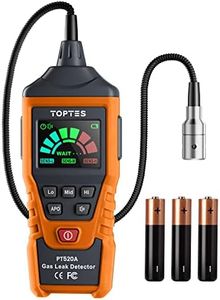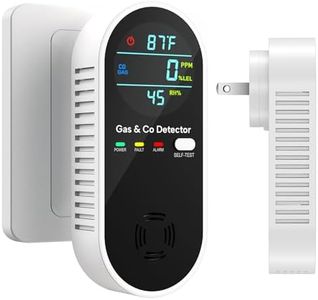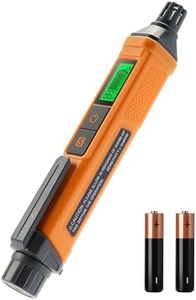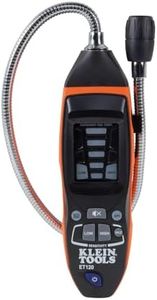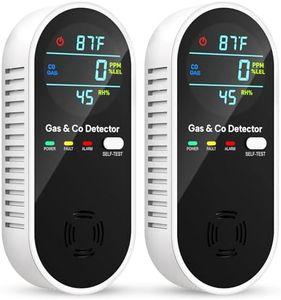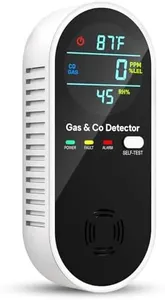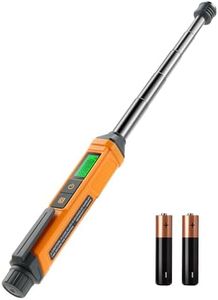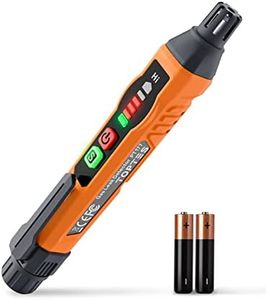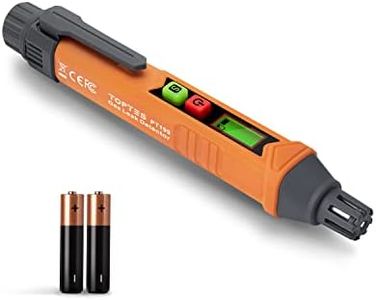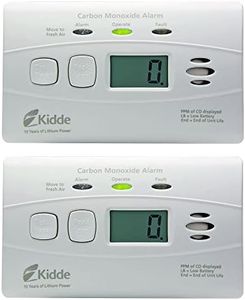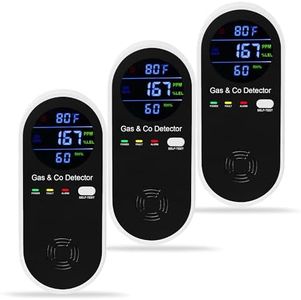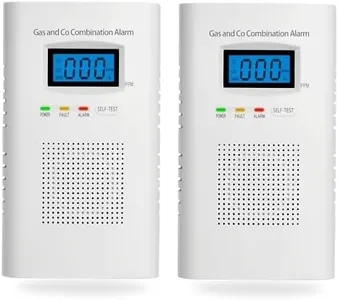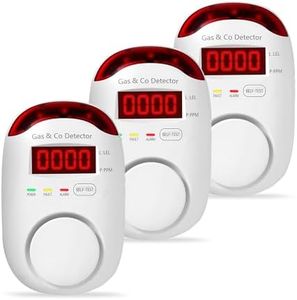10 Best Home Gas Detector 2025 in the United States
Our technology thoroughly searches through the online shopping world, reviewing hundreds of sites. We then process and analyze this information, updating in real-time to bring you the latest top-rated products. This way, you always get the best and most current options available.

Our Top Picks
Winner
4-in-1 Upgraded Natural Gas Leak Detector and Carbon Monoxide Detectors, Dual Sensor Gas Leak Detector & Carbon Monoxide Detectors Plug in (Temperature & Humidity) for Home, RV (Black)
Most important from
1639 reviews
This NICGOL 4-in-1 gas and carbon monoxide detector is a practical choice for homes and RVs needing multi-hazard protection in one compact device. It uses catalytic sensors to detect natural gas and carbon monoxide, along with temperature and humidity monitoring, which can be helpful for safety and comfort. The dual alarm system—both loud sound (85 dB) and flashing red lights—provides clear warnings if dangerous gas levels are detected, which is especially useful for quick response.
It plugs into standard AC power (110V–220V) and is energy efficient, so you don’t have to worry about changing batteries frequently. The clear color LCD screen shows real-time gas concentrations, helping you stay informed at all times. Its small size fits well in tight spaces like kitchens, RVs, or cabins. However, it requires initial setup steps like screen film removal and calibration wait time before use.
While it covers natural gas, carbon monoxide, temperature, and humidity, the sensor’s upper temperature limit is 176°F, which suits normal indoor environments but might not work well in extremely hot areas. This model doesn’t include batteries and relies entirely on AC power, so it won’t work during outages unless you have backup power. If you want a reliable, easy-to-read detector that covers multiple gases and environmental factors without regular battery fuss, this device is a solid pick. Just keep in mind it is best placed indoors in areas with stable power and not exposed to extreme heat.
Most important from
1639 reviews
PT520A Natural Gas Detector, Gas Leak Detector with 17-Inch Gooseneck, Locating The Source Like Propane, Methane, and Butane for Home and RV (Includes Battery x3) - Orange
Most important from
3655 reviews
The TOPTES PT520A is a practical natural gas detector designed for home and RV use, capable of detecting a variety of gases including methane, propane, butane, and other natural gases. It uses an electrochemical sensor, which is reliable for sensing even small leaks quickly. The 17-inch flexible gooseneck probe is a standout feature, allowing you to reach tight or tricky places like behind appliances or inside basements where leaks often occur. This flexibility makes it quite versatile compared to detectors with fixed sensors.
The alarm system is both audible and visual, with a loud 75dB sound and colored bars that increase with gas concentration, helping you gauge the seriousness of a leak. It reacts quickly—within half a second—which is essential for safety. The detection range is focused on close proximity (1 to 5 cm), so you need to get the sensor near the source to get accurate readings. Powered by three AAA batteries (included), it offers portability and ease of use without worrying about cords. Features like auto power-off help save battery when the device is not in use, and a mute button lets you silence the alarm when needed, which is convenient during testing.
The device is lightweight and ergonomically designed with a non-slip grip, making it comfortable to handle during inspections. It comes with a protective case and a manual, which aids ease of use. Its effective detection distance is quite short, so it requires close inspection rather than broad area coverage. It also operates best at temperatures up to 122°F and 80% humidity, sufficient for most homes but possibly limiting in extreme environments. Without smart connectivity or continuous monitoring features, it is best suited for spot checks rather than ongoing surveillance. This makes the PT520A a solid choice for homeowners and RV users seeking a handheld, easy-to-use tool to pinpoint gas leaks in hard-to-access areas without extra technical complexity.
Most important from
3655 reviews
PT205 Natural Gas Detector with Audible & Visual Alarm, Gas Leak Detector with%LEL Value of Methane, Butane, Propane for Home, RV (Includes Batteryx2)-Orange
Most important from
8454 reviews
The PT205 Natural Gas Detector by TopTes is designed to detect a wide range of combustible gases, including methane, butane, propane, and natural gas, making it versatile for home use and RVs. It utilizes advanced sensor technology to measure the Lower Explosive Limit (LEL) concentration percentages, offering accurate detection within a range of 1%LEL to 10%LEL. This feature is crucial for evaluating explosion risks and staying informed about gas levels.
The detector provides both visual and audible alarms for quick identification of gas presence, with high concentrations triggering a red display on the LCD screen, enhancing safety awareness. It has a compact and portable design, equipped with a secure pen hook for easy carrying and a non-slip texture for firm grip, making it ideal for homeowners and RV enthusiasts. The device comes ready to use with two AAA alkaline batteries included, and features a quick 30-second warm-up time, low battery indicator, and automatic power-off to ensure reliability.
Users appreciate its convenience, though the small size might limit the coverage area. The product also boasts certifications such as CE, UKCA, FCC, and RoHS, ensuring compliance with safety standards. However, the compact size may be less suitable for larger homes requiring broader coverage.
Most important from
8454 reviews
Buying Guide for the Best Home Gas Detector
Choosing the right home gas detector is crucial for ensuring the safety of your household. Gas detectors can alert you to the presence of dangerous gases, such as carbon monoxide, natural gas, or propane, which can be harmful or even fatal if undetected. When selecting a gas detector, it's important to consider several key specifications to ensure you get the best fit for your needs. Understanding these specifications will help you make an informed decision and provide peace of mind for you and your family.FAQ
Most Popular Categories Right Now
